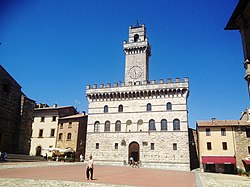Montepulciano
In the 12th century it was repeatedly attacked by the Republic of Siena, which the Poliziani faced with the help of the Perugia and Orvieto, and sometimes Florence, communes.From 1390, Montepulciano was a loyal ally (and later possession[5]) of Florence and, until the mid-16th century, lived a period of splendour with architects such as Antonio da Sangallo the Elder, Jacopo Barozzi da Vignola, Baldassarre Peruzzi, Ippolito Scalza and others, building luxurious residences and other edifices here.After the unification of Italy and the drying of the Val di Chiana, the town remained the most important agricultural centre in the area, while the industrial activities moved mostly next to Chiusi, which was nearer to the railroad being built in that period.A competitive "barrel race through the city" called the Bravio delle botti has been held on the last Sunday of August since the 14th Century.Most of the shops and restaurants are on the main street, which stretches from Porta Al Prato to Piazza Grande[6] for 1.5 kilometres (0.9 mi).
Montepulciano (disambiguation)ComuneRegionTuscanyProvinceFrazioniAbbadiaAcquavivaGraccianoMontepulciano StazioneSant'AlbinoValianoDemonymTime zoneDialing codeRenaissancehill townprovince of SienaPienzaFlorenceVino Nobile di MontepulcianoBrunello di MontalcinoChianti ClassicoRosso di MontepulcianoDenominazione di origine controllataEtruscanLars PorsenaClusiumChiusiRoman timesWestern Roman EmpireLombardsRepublic of SienaPerugiaOrvietoAntonio da Sangallo the ElderJacopo BarozziBaldassarre PeruzziIppolito Scalzaunification of ItalyVal di ChianaBravio delle bottiMichelozzoPalazzo della SignoriatravertineSanta Maria Assunta CathedralSienese SchoolTaddeo di BartoloAndrea della RobbiaMadonna di San BiagiotambourSanta LuciaLuca SignorelliMuseo Civico di MontepulcianoDella RobbiaRobert BellarmineCardinalDoctor of the ChurchAgnes of MontepulcianoAngelo PolizianoFlorentine Renaissanceclassical scholarGiovanni Antonio PandolfiBaustelleassessoriList of twin towns and sister cities in ItalytwinnedMoulinsMadonna di San Biagio SanctuaryCathedralBruscelloCatholic EncyclopediaWikisource1911 Encyclopædia BritannicaComuniAbbadia San SalvatoreAscianoBuonconventoCasole d'ElsaCastellina in ChiantiCastelnuovo BerardengaCastiglione d'OrciaCetonaChianciano TermeChiusdinoColle di Val d'ElsaGaiole in ChiantiMontalcinoMonteriggioniMonteroni d'ArbiaMonticianoPiancastagnaioPoggibonsiRadda in ChiantiRadicofaniRadicondoliRapolano TermeSan Casciano dei BagniSan GimignanoSan Quirico d'OrciaSarteanoSinalungaSovicilleTorrita di SienaTrequanda